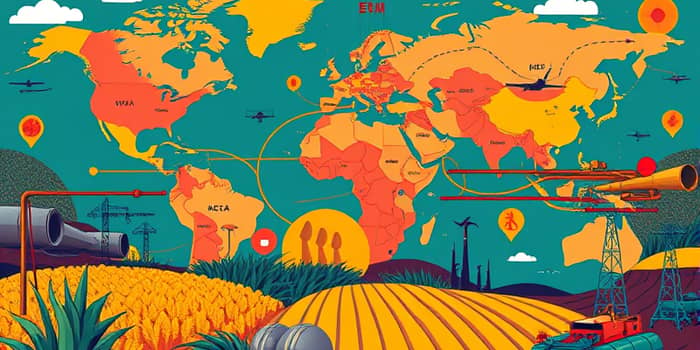
In an era defined by rapid political shifts and strategic rivalries, investors and policymakers must navigate an increasingly complex web of uncertainties. This article examines the drivers of geopolitical risk, the channels through which shocks transmit to markets, and practical tools to build resilience.
Geopolitical risks arise from political instability and major power tensions, encompassing conflicts, diplomatic frictions, and abrupt changes in alliances. These threats can derail economic forecasts, spark market turmoil, and strain supply chains that underpin global trade.
Understanding these risks is essential because they influence core economic indicators—growth rates, inflationary pressures, currency valuations, and commodity prices. The Coface political risk index, at 40.2%, remains above pre-pandemic levels, underscoring the elevated baseline of uncertainty facing businesses and governments.
Several flashpoints dominate the landscape today:
These hotspots not only generate acute shocks but also fuel long-term fragmentation of global markets.
Geopolitical events propagate through several economic channels:
Market volatility spikes almost immediately after major news, with sector-specific and local assets typically enduring the longest drawdowns. Energy and agriculture markets are especially sensitive, reflecting supply disruptions in Russia and Ukraine.
Sustained inflationary pressures emerge as commodity prices surge. Advanced economies are grappling with inflation above pre-pandemic levels, partly driven by tight energy markets and food shortages.
Policy responses—tariffs, export controls, and strategic stockpiling—reshape trade flows. Governments apply economic statecraft to protect critical industries, further fragmenting global value chains and raising costs for multinational firms.
Banks and financial institutions face elevated exposures to credit, liquidity, and operational risks. Cyber attacks have tripled among EU/EEA banks since 2022, demonstrating the growing threat from digital espionage and AI-driven misinformation.
Credit and sovereign risk widen as rating agencies reassess vulnerable economies with high reliance on a single commodity or trade partner. Capital flight can destabilize emerging markets, while advanced economies adjust monetary and fiscal policies to counteract imported inflation.
The shift toward shifting global power dynamics is evident in the rising influence of BRICS+ nations. Although unable to displace the US dollar as the dominant reserve currency, these countries are forging alternative financial corridors, intensifying fragmentation.
Technological advancements bring both opportunities and risks. AI-driven automation and cybersecurity innovations can bolster resilience, yet they also introduce new vulnerabilities that institutions must address.
Long-term, the Asia-Pacific region remains poised as the long-term economic growth engine, despite persistent regional tensions. Investors need to balance growth prospects with geopolitical sensitivities.
Recent examples illustrate these dynamics:
These data points highlight how swiftly and intensely markets can react to political shocks, making proactive risk assessment indispensable.
Organizations and investors can adopt several strategies to navigate this fragile geopolitical landscape:
Financial institutions are also strengthening stress-testing scenarios to incorporate concurrent shocks—such as a cyber-attack amid a political crisis—to gauge potential capital needs and liquidity strains.
Global economic governance faces a paradox: coordination is more vital than ever, yet institutional fragmentation is accelerating. Regional blocs are increasingly setting divergent trade and security rules, complicating unified responses to systemic risks.
The persistence of the US dollar as the primary reserve asset underscores the resilience of established systems, even as new financial networks emerge. Policymakers must balance national security concerns with the need for open markets to foster growth and innovation.
Ultimately, navigating geopolitical market risks demands both vigilance and flexibility. By embracing proactive resilience-building measures and fostering cooperation across borders, stakeholders can transform uncertainty into an opportunity for sustainable progress.
References













